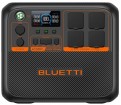Add to comparison |  |  |
|---|---|---|
| BLUETTI AC200P L | EcoFlow DELTA Pro | |
from £1,899.00 | Compare prices 6 | |
| User reviews | ||
| TOP sellers | ||
2 USB A ports, 1 USB C port. Car cigarette lighter, RV port. Jumps up to 3600 W are allowed. LiFePo4 battery. Wireless charging power 15 W (2 fields). | 2 USB A ports, 2 USB A Fast Charge ports, 2 USB C ports. Transport wheels. Bluetooth support. Anderson port, car cigarette lighter port, DC5521 port, Infiniti port. LFP - lithium iron phosphate battery. Capacity 3600 Wh | |
| In box | charging station | charging station |
| Rated power | 2400 W | 3600 W |
| Peak power | 3600 W | 7200 W |
| Output waveform | sinusoid (PSW) | sinusoid (PSW) |
| UPS function | ||
Outputs | ||
| Sockets (230 V) | 4 | 4 |
| USB A | 2 5В/2.4А 12 W | |
| USB A (quick charge) | 2 5В/3A, 9В/2A, 12В/1.5A 18 W | 2 5В/2.4A, 9В/2A, 12В/1.5A 18 W |
| USB C | 2 3 A, 5 A 100 W | 2 5 A 100 W |
| Wireless charger | 2 zones 15 W | |
| Car cigarette lighter | ||
| Add. ports | RV (48 H / 8 A) | USB B |
Inputs (station charging) | ||
| From solar panels | ||
| Input port XT60 | ||
| Anderson port | 12.6 / 30 A | |
| Add. ports | Infiniti | |
Battery and charging time | ||
| Connecting an additional battery | ||
| Battery type | LiFePO4 | LiFePO4 |
| Battery capacity | 2304 W*h | 3600 W*h |
| Charging cycles | 3000 | 3500 |
| Charging time (socket) ≈ | 60 min | 114 min |
| Charging time (solar panel) ≈ | 168 min | 135 min |
| Charging power (socket) | 2400 W | 1800 W |
| Charging power (solar panel) | 1200 W | 1600 W |
| Charging power (socket + solar panel) | 2400 W | |
General | ||
| Smartphone synchronization | Bluetooth and WiFi | Bluetooth and WiFi |
| PSU | built into the body | built into the body |
| Display | ||
| Wheels for transportation | ||
| Carrying handle | ||
| Operating temperature | 0 °C ~ +40 °C | -20 °C ~ +45 °C |
| Dimensions | 367x420x280 mm | 416x285x635 mm |
| Weight | 28.3 kg | 45 kg |
| Warranty | 5 years | 3 years |
| Added to E-Catalog | june 2024 | september 2022 |
The charging stations BLUETTI AC200P L and EcoFlow DELTA Pro each have their unique advantages. The BLUETTI AC200P L offers a rated power of 2400 W and a peak power of 3600 W, making it suitable for most household needs. It is equipped with a LiFePO4 battery with a capacity of 45 Ah and supports up to 3000 charging cycles, ensuring long-lasting service life. Users note the convenience of use due to multiple outputs, including wireless charging. At the same time, the EcoFlow DELTA Pro stands out with a higher rated power of 3600 W and peak power of 7200 W, allowing the connection of more powerful devices. The battery capacity is 75 Ah with 3500 charging cycles, which is also a significant advantage. Users appreciate the presence of wheels for transportation and a wider operating temperature range. Both devices support Bluetooth and Wi-Fi for smartphone synchronization, but the DELTA Pro has faster charging from the grid. The choice between them depends on your needs for power and mobility.